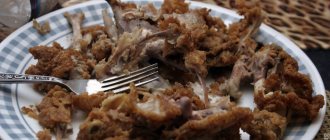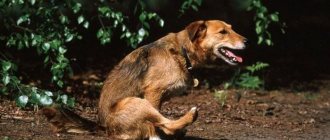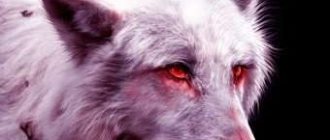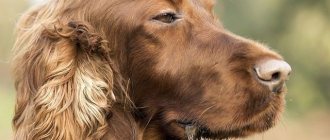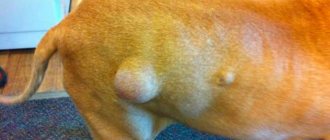Main characteristics of the disease
Pinched intervertebral nerves are a condition where the nerve roots that connect the spinal cord to the spine are compressed.
The difficulty is that in some cases the pathology can easily be confused with diseases such as osteoporosis, sarcoma, osteochondrosis, spondyloarthrosis, soft tissue contusion and others. Thus, it is necessary to highlight the most basic types of pinched nerves in dogs:
- the nerve of the cervical spine may be pinched;
- Damage to the vertebral part of the chest may occur;
- discopathy in dogs, the treatment of which is quite complex;
- pinches the sciatic nerve.
It is also necessary to pay attention to the fact that if any of the upper parts of the spine are pinched, this is fraught with complications, including paralysis. If the sciatic nerve is pinched, the pet feels very severe pain in the hind limbs, which without proper treatment can lead to complete atrophy and loss of sensitivity.
Reasons for development
Depending on which part of the spine the compression occurs, pinching of the cervical, thoracic or sacral (sciatic) nerve is distinguished. Nerve root compression is most often a consequence of spinal pathologies: intervertebral hernia, spondylosis, osteochondrosis. A pinched nerve in a dog can be caused by:
- injuries that caused displacement of the vertebrae;
- increased load on the spinal column;
- the presence of a tumor in the spine area;
- calcium metabolism disorders;
- frequent hypothermia.
Age factors and genetic predisposition are also important. In older dogs, the processes of bone tissue restoration are slower, the vertebrae are more easily deformed and, even with a slight load, can shift, pinching a nerve. Dog breeds that are prone to the development of this pathology are those that are heavy and have a loose constitution (mastiffs, Dogues de Bordeaux, St. Bernards), as well as short-legged dogs with a long body - dachshunds, basset dogs, bulldogs.
Features of correct diagnosis
As for diagnostics, there are some nuances and features. Very often it is problematic to establish where exactly the inflammation is localized and what nature it has. If the animal has had an injury and pinching is its consequence, the doctor will initially determine the source, and then only look for the pinching.
In any case, as soon as you notice that your pet’s behavior has changed and something is causing him pain, you should immediately seek advice from a specialist, this will greatly facilitate the diagnosis and subsequent treatment process.
In most cases, diagnosis and treatment of spinal discopathy in dogs is not particularly difficult, however, there are a number of symptoms that should significantly alert the owner of the animal:
- the dog does not allow his back to be touched;
- the dog drags its hind legs and does not raise its tail;
- if a dog has a spinal hernia, the symptoms may be limited to frequent changes of posture and whining, but treatment can be quite lengthy;
- there is a reaction to changing weather conditions;
- protrusion syndrome can actively manifest itself during games or walking an animal;
- the puppy does not want to play and spends almost all his time alone;
- movements are constrained, limited, and sharp pain may be felt.
Bacterial and viral pathologies
Discospondylosis is an inflammation of the above-described intervertebral disc , the structure of which has been written about a lot above. In quite frequent cases, the inflammatory process can occur without the influence of pathogenic microflora. But more often, the cause lies either in a bacterial/fungal infection, or in an autoimmune disease, when the destruction of intervertebral disc tissue occurs due to the action of the body’s own immune system.
Large breeds are much more likely to develop this pathology. The most common symptom is severe pain when palpating the back.
Some dogs develop fever, depression and exhaustion. As a rule, neurological seizures, paralysis and paresis develop against the background of mechanical pressure to which the spinal cord is exposed. In more rare cases, they are caused by infection entering directly into the spinal canal. Blood and urine tests help accurately identify the threat in each specific case.
Symptoms of the lesion may disappear after as little as five days after a suitable antibiotic is prescribed, but treatment usually lasts for at least eight weeks.
Rickettsial diseases. Dogs that have contracted this disease clearly show signs of spinal cord dysfunction. Rickettsial infections, among other things, are almost always accompanied by severe secondary infections , such as Rocky Mountain meningococcal meningitis and ehrlichiosis, which directly affect the spinal cord tissue. Blood and urine tests are also used to identify infection. Antibiotic therapy is the only treatment method. Its duration can reach two to three weeks. With rapid initiation of therapy, the prognosis is good, but in advanced cases euthanasia is recommended.
Encephalomyelitis caused by the causative agent of canine distemper . A very severe viral infection that causes swelling of the lining of the brain and spinal cord. Neurological signs may appear suddenly, but in most cases the pathology develops over several days. It all starts with fever and severe pain in the back and ends with paralysis. It is very difficult to make an accurate diagnosis without an autopsy.
There is no specific treatment and is not yet expected ; if paralysis develops, the prognosis is unfavorable; euthanasia is recommended. Only timely vaccination can prevent such a sad outcome. What other spinal diseases occur in dogs?
Intervertebral nerve pinching. Causes of pathology
As for the disease, the symptoms of osteochondrosis in dogs and the main treatment primarily boil down to the fact that this condition is a consequence of an already existing problem. Consequently, the owner did not notice the onset of any inflammatory process and did not seek help from a specialist in time. The disease took on a chronic course, which became the cause of such acute pinching.
If we talk about the root causes, then for the most part they can be as follows:
- spondylosis;
- untreated radiculitis;
- intervertebral hernia in dogs for which no treatment was carried out;
- benign tumors;
- malignant osteosarcoma in dogs for which no treatment was carried out;
- the vertebra could have been injured, but this went unnoticed by the owner and the veterinarian;
- scoliosis;
- prolapse or osteochondrosis of an old type;
- violation of metabolic processes;
- frequent hypothermia.
What is a pinched nerve?
A pinched nerve in a dog is usually called an incredibly serious disease, which can occur for completely different reasons, which will be discussed a little later. Let us only mention that most often this happens as a result of local aging of certain segments of the spine.
Thus, serious degenerative changes occur, and osteophytes appear on the spine, that is, growths of bone tissue, which compress the nerve roots, worsening the animal’s condition. For this reason, the disease is considered age-related, as it is incredibly rare to occur in dogs under 6 years of age.
In most cases, the term “pinched nerve” refers specifically to the situation of pinching the spinal process root by intervertebral discs. This manifestation is very dangerous, since even mild forms of the disease are most often manifested by severe sensory disturbances, as well as limited mobility of all limbs.
As for more severe cases, the dog can become completely paralyzed. This is also accompanied by pain, but despite all this, even specialists cannot immediately determine the place where this nerve was pinched. The fact is that clinical manifestations, the list of which will be given below, can occur in both the lower and upper parts of the spine.
Your task is not to try to determine the location of the compression, but to take the dog to a specialist as quickly as possible when the first signs appear. It is worth mentioning that successful treatment is only possible in situations where the veterinarian began to provide assistance in the early stages. And then the disease will not cause the pet serious pain. Everything in this case depends on the owner’s attentiveness to the animal.
Causes of a pinched nerve
To understand how to protect your pet as much as possible from such a disease, it is important to identify the main reasons for its development. Let us immediately mention that compression can occur not only due to the fault of bone tissue. Compression by soft tissue, such as cartilage, tendons, or even muscles, can also cause serious pain. This type of compression often occurs in the presence of any inflammatory processes in these soft tissues. The problem may also be the presence of edema or even parasites.
At this stage, most often the symptoms are already very pronounced and it is impossible not to notice the pet’s health problems. The development of the sciatic nerve may generally result in the inability to walk on one’s feet. Movement will only occur while sitting, and this process is incredibly painful.
Experts note that the problem most often lies either in the very upper part of the spinal column or in the neck. It is worth mentioning that such a high localization of the problem does not prevent the occurrence of paralysis of any lower areas of the body, and especially the limbs. For this reason, pinching of the spinal nerve is considered to be the most severe case. Regardless, each situation should only be treated and diagnosed by an experienced veterinarian.
Spondylosis
This pathology mostly affects the body of an elderly animal. This is due to the fact that with age, changes in the segments of the spine occur. Most often this is associated with degeneration of the spinal discs and is localized in the anterior or middle part.
As for the development of the disease, it most often occurs as a result of injuries or other disorders. It should also be noted that the risk of developing pathology is most often observed in pets who are genetically prone to this.
The pathology clinic manifests itself as follows:
- the dog begins to move very difficultly;
- slowness;
- the dog does not allow you to touch his back;
- the examination is difficult due to the unpleasant sensations in the pet.
Spondylosis in dogs is mostly diagnosed using x-rays, and treatment is intensive and complex.
Radiculitis
Radiculitis is pinching of the spinal cord roots. This pathology can also cause a pinched spinal nerve in a pet. The main signs of pathology are, for the most part, severe pain and the animal’s reluctance to move actively. If we talk about the causes of radiculitis, then these are hypothermia, injury or infectious processes.
In order to avoid the occurrence of disease, it is necessary to monitor the health of your pet. Very often, this pathology occurs in dogs that have any anomalies of the spinal region.
Degenerative lesions of intervertebral discs
The spinal cord is one of the most important and sensitive organs in the animal's body. If its tissues are damaged, the defects are not restored, but are only replaced by fibrous connective tissue.
Important! Spinal cord lesions usually result in permanent, irreversible paralysis, the treatment methods for which are still in their infancy (in medicine, veterinarians do not do this at all).
To protect against damage, the spinal cord is located in the spinal canal and is covered by bone everywhere, except at the joints of individual vertebrae. These joints are filled with rubbery pads called intervertebral discs. This design allows the back to move in almost all directions.
The disc is made up of two parts. The outer covering (annulus fibrosus) resembles a large, thick mollusk shell. It consists of tough fibers that protect and hold the central part (the fleshy core). Just below the spinal cord is the thinnest part of the disc. If the shell of the intervertebral disc is similar in consistency to rubber, then the central part is more like toothpaste.
The degenerative disease causes the outer portion of the disc to weaken, causing the lining to rupture and form a herniation . It is generally accepted that injuries lead to this, but this is not entirely true: indeed, strong mechanical impacts can contribute to the occurrence of a hernia, but they act as a “trigger” and are not the direct cause.
Note! Accumulated statistics show that most often dogs between the ages of five and seven years suffer from herniated discs.
Today experts believe that this disease is genetically determined . Certain breeds, especially Dachshunds, Poodles, Pekingese, Lhasa Apso, German Shepherds, Doberman Pins and Cocker Spaniels, have the highest chance of developing a herniated disc. What are the symptoms and diagnosis for this pathology? It all depends on the current stage of the disease:
- The first stage is characterized by sharp, but quickly and spontaneously passing pain .
- At the second stage , pain, even if not too severe, constantly appears upon palpation of the lumbar region.
- At the third stage, partial paralysis occurs . In milder cases (which is much less common), the dog experiences difficulty coordinating movements .
- At the fourth stage, complete or partial paralysis develops in 100% of cases, but the sensitivity of the skin is still fully preserved.
- The fifth stage is characterized by both paralysis and complete loss of sensation .
Hernia of intervertebral localization
The main sign that an animal has developed an intervertebral hernia is that there is a bulging of the vertebral disc due to rupture of fibrous tissue. As for this effect, the nerve roots seem to be compressed and, as a result, pinching begins. It is also very important to note that a hernia can be either acute or chronic. Here, only the operation is shown, since homeopathic and traditional methods in most cases are absolutely powerless.
Tumors and other neoplasms of the vertebral body
In the event that a pet suffers from a pinched nerve, this may be the most direct reason that it develops some kind of tumor process. If you do not pay attention to the pathology, this can lead to both serious consequences and complete paralysis of the pet’s limbs.
The main treatment method involves complete removal of the tumor and chemotherapy. If your pet cannot move independently, it would be advisable to purchase a special wheelchair for dogs.
Basic treatment measures
Treatment for prolapse or pinched nerve endings in a dog involves a rather complex set of therapeutic measures. Initially, it is worth noting that the pathology has very pronounced symptoms, which provides for the initial relief of pain. Only after the acute symptoms have been eliminated are medications prescribed to treat the nervous disease specifically.
As for the main symptomatic therapy, it includes the following measures:
- painkillers are used to relieve acute pain;
- non-steroidal drugs are used to eliminate the inflammatory process as much as possible and alleviate the dog’s condition;
- using sedatives to calm the dog down;
- Sports and other activities should be limited as much as possible so that the dog does not experience acute pain.
After the acute condition has been eliminated to the maximum, it is necessary to resort to therapeutic manipulations of the animal’s nervous system:
- Intensive vitamin therapy.
- Use of homeopathic medicines.
- Physiotherapeutic procedures and massage.
- Surgical intervention followed by rehabilitation.
Thus, manipulations are completely impossible to perform at home.
If a dog has a pinched nerve, hospital treatment is simply necessary.
If we talk about the prognosis, it is mostly positive. However, this can only be achieved with timely seeking help and proper treatment.
Treatment methods
A pinched nerve is a consequence of a systemic disorder, so the approach to treatment must be comprehensive. First of all, you need to relieve pain. After this, begin to eliminate the root cause of the symptom.
In case of acute attacks of compression, the dog should be provided with complete rest. Place it in a secluded place away from drafts. The room should be warm. Periodically, you need to turn the dog over to the other side to avoid bedsores. From time to time you need to ventilate the room to bring in fresh air. If the animal's condition is stable and the animal can move, the dog can be walked. But walks should be gentle without physical activity. It is strictly forbidden to jump or go down stairs.
First you need to alleviate the dog’s condition and eliminate the pain. To do this, the pet is given painkillers. These may be NSAIDs. They have not only anesthetic, but also anti-inflammatory properties. Do not use human drugs (Aspirin, Indomethacin). They can cause gastrointestinal disorders and bleeding in animals.
Dogs can be given:
- Quadrisol;
- Rimadyl.
To calm your pet, use sedatives:
- Sedavit;
- Novopassit.
It is very important, after relieving the pain symptom, to restore the conduction of nerve impulses and take measures to strengthen the structures of the spine. B vitamins have a positive effect on the functioning of nerve fibers.
Vitamins can be added to complex therapy:
- Neurovitan;
- Malgamma;
- Neurorubin.
To restore neuromuscular conduction, Proserpine is prescribed. But it can be used only after the end of the acute phase of the disease. In the early stages of the pathological process, it can be stopped using homeopathic remedies. To resolve deposits on the vertebrae, Lidaza is administered.
Complex therapy should also include massage and physiotherapy.
If all conservative measures fail and the dog remains immobilized due to a pinched nerve, surgery may be necessary. But intervention does not always guarantee a positive result. During the operation, the spinal cord and surrounding tissues may be damaged. Intervention is carried out only in extreme cases; it should only be done by a highly qualified specialist.
What antibiotics can be given to dogs and how to calculate the dosage of medications? We have the answer!
The first signs, symptoms and effective methods of treating oily seborrhea in dogs are described in this article.
Preventive measures
In order to ensure that your pet’s health is at the proper level, it is necessary to promptly respond to all alarming manifestations and deviations from the norm. It is also worth performing simple daily exercises to ensure that the dog remains active and does not encounter problems with the nervous system:
- Physical activity should be moderate, but daily.
- Rest is the key to your pet's health. The dog should alternate rest with active activity.
- The basic diet should be filled with all useful elements, such as vitamins and minerals.
- It is worth protecting your dog from hypothermia.
To summarize, it is worth noting that a pinched nerve in a dog is a pathology that can be treated quite effectively, however, subject to timely seeking help from a specialist. If a dog is prone to nerve pathology, it is necessary to periodically carry out supportive measures using special medications.
Dog has back pain symptoms and treatment
A responsible owner always tries to help and is very worried when his beloved dog gets sick. A pinched nerve is very serious, and there may be several reasons why it happened. Only a veterinarian can establish an accurate diagnosis, therefore, as soon as symptoms appear, go straight to the veterinary clinic.
Pinched nerves in dogs often occur due to local aging of spinal segments - spondylosis. With this disease, degenerative changes occur and osteophytes - bone growths - are formed. Such growths begin to irritate the anterior longitudinal ligament of the spine; often the bodies of adjacent vertebrae become fused because of them. Osteophytes put pressure on the nerve roots and narrow the spinal canal, causing severe pain and, in extreme cases, paralysis.
This disease progresses slowly and first affects the outer fibers of the fibrous ring.
Time passes and the animal becomes less mobile. Most often, this disease affects dogs over 6 years of age, if there are no manifestations of lumbago and sciatica.
The development of this age-related disease is facilitated by prolonged static load due to spinal injuries, postural disorders, hypothermia, osteochondrosis, and metabolic disorders.
There is also a hereditary factor.
The main external manifestation of spondylosis is limited mobility in the lumbar spine. When the stage of the disease is moderate, due to painful sensations the animal refuses to move on inclined surfaces and stairs, or jump.
The dog has difficulty getting up and lying down, and when pressure is applied to the back, it reacts painfully. The pain also increases after prolonged immobility and when the weather changes. The shape of the back changes noticeably, and the chest seems to harden.
In severe form, complete or partial paralysis and loss of coordination are observed. Typically, spondylosis is diagnosed after X-ray examination of other diseases.
Vitamins B1, B6, B12, or their complex preparations - neuromultivitis, milgama, are also prescribed, but you need to know that such drugs stimulate the growth of tumors (subject to their presence). Be sure to prescribe proserin, it restores neuromuscular conduction. The most important thing here is to choose the right dose and course duration. This medicine is not used in the acute phase of the disease.
When the case is not advanced, homeopathic medicines work well. The goal of this treatment is to stop further tissue destruction. You can also use absorbable agents to dissolve the growths (lidase injections).
To relieve pain, painkillers are prescribed for dogs. Electropuncture and acupuncture, acupressure also provide a good therapeutic effect, and a course of chodroprotectors activates metabolic processes.
A pinched nerve in a dog may be associated with sciatica. Bassets, Pekingese and Dachshunds are most susceptible to this scourge.
This disease is characterized by damage to the nerve roots of the spinal cord. The reason is spinal injury, osteochondrosis, heavy loads and hypothermia.
Symptoms are the inability to move the hind legs, curvature of the spine, pain that occurs when moving, tension in the back muscles. In such cases, the animal is urgently taken to a veterinarian for examination.
Treatment can be at home, but must be comprehensive. First, the animal is given an anesthetic (any non-steroidal anti-inflammatory drug). Next, a course of anti-inflammatory therapy and treatment aimed at the passage of nerve impulses through peripheral nerve endings is carried out.
